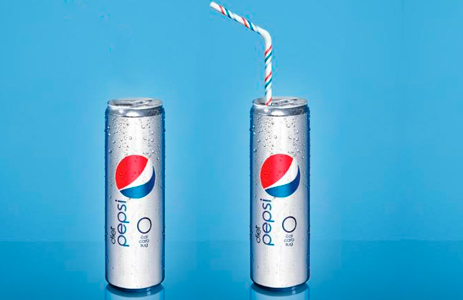 Skinny Diet Pepsi: the latest fashion faux pas.At the just-launched Fashion Week in Manhattan, supermodels won’t just be sashaying down runways in mind-boggling frocks. They’ll also be accessorized with a new invention from Pepsi Co. — the “skinny can,” pictured at right, which (according to a press release) will “make its debut” in the cool palms of fashionistas during the twice-a-year blowout at Lincoln Center.
Skinny Diet Pepsi: the latest fashion faux pas.At the just-launched Fashion Week in Manhattan, supermodels won’t just be sashaying down runways in mind-boggling frocks. They’ll also be accessorized with a new invention from Pepsi Co. — the “skinny can,” pictured at right, which (according to a press release) will “make its debut” in the cool palms of fashionistas during the twice-a-year blowout at Lincoln Center.
What Pepsi is calling its “taller, sassier” new can, a “celebration of beautiful, confident women,” amounts to new packaging for a very old and familiar product: Diet Pepsi. And just what is this thing called Diet Pepsi? Here’s the official ingredients list:
CARBONATED WATER, CARAMEL COLOR, ASPARTAME, PHOSPHORIC ACID, POTASSIUM BENZOATE (PRESERVES FRESHNESS), CAFFEINE, CITRIC ACID, NATURAL FLAVOR
PHENYLKETONURICS: CONTAINS PHENYLALANINE.
In plain English, Diet Pepsi consists of artificially blackened water tarted up with synthetic chemicals. The references to “natural flavor” and (chemical-induced) “freshness” aside, what really gives Diet Pepsi its main flavor — that special jolt of sweetness — is aspartame, the famous calorie-free sugar substitute.
What aspartame lacks in calories it more than makes up for in baggage. Italian researchers recently added [PDF] to a long-standing and growing body of literature pointing to aspartame’s possible role as a carcinogen. Their conclusion, published in Environmental Health Perspectives, was stark: “The results of this mega-experiment indicate that [aspartame] is a multipotential carcinogenic agent, even at a daily dose of 20 mg/kg body weight, much less than the current acceptable daily intake.”
How did the FDA ever allow it into the food supply, where it now flourishes as the industry’s go-to fake sweetener? Funny you should ask. The agency’s decision to approve aspartame, which came down during the Reagan era, ranked as its most controversial ever at the time. The story is a lively one — it involves Donald Rumsfeld, George W. Bush’s famously gruff defense secretary, now making headlines as he pimps his newly published memoirs; and Monsanto, that ever-charming agrichemical giant.
It goes like this: In the early 1980s, a company called Searle owned the patent on aspartame, already known, paradoxically, as Nutrasweet. (I get the sweet part, but nutra?) Searle’s CEO was the well-connected Rumsfeld — who took the Searle job not long after serving as secretary of defense for the previous Republican president, Gerald Ford.
In 1981, President Reagan appointed a man named Arthur Hull Hayes as his FDA chair. Soon after taking the post, Hayes approved aspartame over the objections of an FDA-assembled panel made up of independent scientists. That panel had voted to reject clearence of aspartame, on the grounds that one of Searle’s own studies had shown that rats that consumed the chemical showed an increase in brain tumors. (This 2006 New York Times article gives a good historical account of the process.)
Rummy, of course, would go on to greater things, but not before engineering the sale of Searle and its suddenly quite valuable Nutrasweet division to Monsanto in 1985. Under Monsanto’s ownership, aspartame conquered the diet soft-drink market. In 2000, Monsanto opted to focus on genetically modified seeds and pesticides, and so it sold Nutrasweet to a private-equity firm at a tidy profit. As for Hayes, he exited the FDA soon after the aspartame approval and launched a robust business career — first as a consultant to Searle’s PR company, Burson-Marsteller, and later as a biotech exec and serial corporate board sitter. (Hayes died from leukemia last year.)
And after all these years, the dodgy chemical Rumsfeld and Hayes rammed through the FDA over scientists’ objections remains our No. 1 diet soda sweetener — and will soon be gracing Manhattan’s fashion runways inside adorable new cans.
Meanwhile, in uptown Manhattan, scientists have been studying the health effects of quaffing all this diet brew. The results should send shivers down the lovely spines in Bryant Park:
In findings involving 2,564 people in the large, multi-ethnic Northern Manhattan Study (NOMAS), scientists said people who drank diet soda every day had a 61 percent higher risk of vascular events than those who reported no soda drinking.
By “vascular events,” the study authors mean to say “strokes.”
Now, importantly, what the researchers found was correlation, not causation. That is, they found that diet soda drinkers tend to have way more strokes than non-soda drinkers; but they didn’t prove that drinking diet soda was the direct cause. It could be that people who drink diet soda are also more likely to consume junk food, or live stressful lives. I’d like to see more research on diet soda that controls for diet. (Importantly, though, the NOMAS study did control for calories — meaning that the surge in strokes for diet-soda drinkers can’t be attributed to overall calorie intake.)
In the end, diet soda is anything but sexy. Considering the carcinogenic potential of aspartame and the link to strokes, smart fashionistas will flush their Diet Pepsi and fill those fancy cans with good old tap water.
Related:



